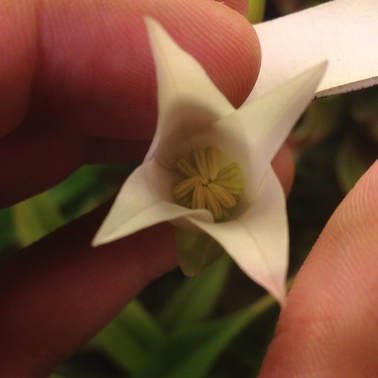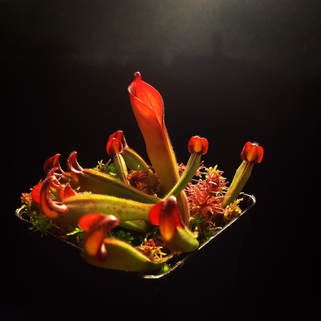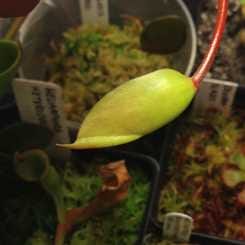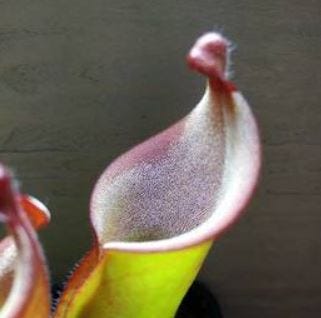GROWING HELIAMPHORA
Introduction
Heliamphora, known colloquially as marsh pitchers, is a genus of some 23 pitcher plants native to South America. The common name "sun pitchers" is an incorrect translation; the genus was named based on the Greek helos (marsh) and not helios (sun). Until recently, Heliamphora have been fairly obscure; their popularity in cultivation didn't take off until the 1990s, and the majority of the species have been discovered within the past few decades. Their range is limited to South American tepuis (tapletop mountains with sheer sides that cut them off from the ecosystems below). If grown properly, Heliamphora can be the highlight of a collection. If one is able to provide the proper conditions (which will be discussed at length below) for these plants, I don't believe that they are as difficult as people tend to suggest. With the wealth of information available today and an improved understanding of the biology of these plants, growers have found growing Heliamphora to be easier than people in the past have suggested, although I certainly wouldn't recommend them as beginner plants.
Lighting, Temperature, and Humidity
In general, there are 3 pillars to follow when cultivating Heliamphora: high humidity, cool temperatures, and bright light. These conditions make the smaller-sized Heliamphora very well-suited to growing in a terrarium. Believe me when I say that the importance of light cannot be understated; these plants will take as much light as you can give them, developing a beautiful red color if given enough (the nectar spoons will fail to develop properly if insufficient light is provided). Here inlies the problem for many growers: abundant light oftentimes means abundant heat. Don't fall into the trap!
For the most part, Heliamphora do not like heat. The high altitude of their native location means that daytime temperatures are somewhat cool and that nighttime temperatures are even cooler (I'd go so far as to say cold). These plants seem to do best for me when daytime temperatures stay below 80°F. My nighttime temperatures are in the upper 50s, but anything below 65°F should be more than suitable. I'd recommend keeping the nighttime temperature above 45°F. Warm temperatures will lead to an eventual (or oftentimes very rapid) death for most Heliamphora.
In order for plants to pitcher properly, high humidity is a must. I would not suggest humidity below 60%, though some growers claim to have acclimated easier species like H. minor and H. heterodoxa to humidity lower than that. In the wild, these plants are oftentimes covered in clouds and experience nearly 100% humidity. I keep my Heliamphora moist, but not wet. Both the tray method (if not overdone) and topwatering seem to work well. Just don't let them dry out!
Media
Most growers recommend an airy substrate. I've found pure live Sphagnum moss to work best, though I've seen many people have success with 50% dead long-fibered sphagnum / 50% perlite and other Sphagnum-based mixes with components such as bark and pumice/lava rock. At the same time, some growers have successfully grown Heliamphora in 100% peat (pretty much as far from being airy as possibly). What's the takeaway from this? In general, an airy mix is a good idea, though the plant probably won't mind otherwise if all other conditions are ideal. Heliamphora roots do not appreciate anaerobic conditions.
Fertilization
Heliamphora benefit from regular, careful fertilization. An insect or Osmocote pellet thrown into the pitchers once in a while works quite well. I water my plants once a month with the same 1/4 strength orchid fertilizer I use on my Nepenthes with good results. Osmocote pellets may also be placed in the soil as well. Much like Nepenthes, although Heliamphora are somewhat tolerant of nutrients in their soil, overdoing fertilization can have fatal consequences. It is better to err on the side of caution when fertilizing these plants.
Propagation
Once a healthy plant starts producing adult pitchers, there is a good chance that you will see it begin to develop flowers. Heliamphora do have complete flowers, but by the time the anthers are ready to release their pollen, the stigma is no longer receptive. The stigma only remains receptive for a short time on the order of a few days, or even less. You will need to have extracted pollen ready for an opening flower if you want to produce seed, but even extracting the pollen can be difficult - the plants are buzz-pollinated by bees and other insects in the wild, so many growers attempt to emulate this by using a tuning fork to "buzz" the pollen out of the anthers. Harvesting the pollen at the right time (just when the anthers have turned yellowish from their original green color and are starting to move to be more parallel to the pistil) is critical. Viable pollen may be stored dry in the freezer. All Heliamphora are capable of breeding with each other as far as we know, so the creation of complex hybrids is possible. Growing Heliamphora from seed is a slow process but can yield many genetically unique plants if done correctly.
Heliamphora will also form divisions over time that can be separated to yield new plants. Pitcher pullings are occasionally successful on small, juvenile plants.

Final Notes
You've heard me use "in general" and "most Heliamphora" very often. What are the exceptions that I'm referring to? Heliamphora ciliata and, according to some growers, some forms of Heliamphora heterodoxa from lower elevations in the Gran Sabana are tolerant of/enjoy warmer temperatures. These plants make up a minority of Heliamphora and are not too common in cultivation.
Even if proper conditions are adhered to, Heliamphora are still fairly slow growers. They appreciate stability and can be set back by change (repotting, acclimating to new conditions, etc.) So, if you've just purchased a new plant and are experiencing pitcher die-off, that's probably why. Even though most Heliamphora grow in the same manner, I'd recommend that beginners start out with H. minor, H. nutans, H. heterodoxa, or a hybrid of those species; they're more tolerant of mistakes and can accept a wider range of growing conditions.









